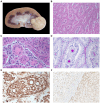Case report: Renal adenoma in a captive ocelot (Leopardus pardalis) in Costa Rica
- PMID: 38756505
- PMCID: PMC11097658
- DOI: 10.3389/fvets.2024.1393039
Case report: Renal adenoma in a captive ocelot (Leopardus pardalis) in Costa Rica
Abstract
Reports of renal neoplasia are rare in neotropical wildcats. Ocelots (Leopardus pardalis) are medium-sized wildcats living in America's tropical forests. A 12-year-old captive ocelot was diagnosed with a renal mass occupying approximately 25% of the total right kidney volume. The tissue was stained with routine hematoxylin and eosin (H&E) and periodic acid-Schiff (PAS). Immunohistochemistry with the following markers was performed: cytokeratin (CK) AE1/AE3, CK19, CK 7, CD10, vimentin, Melan A, HMB45, Pax-8, and Wilms' tumor 1 (WT1). Histopathology revealed a well-differentiated epithelial tubular neoplasia with less than one mitotic figure per 2.37mm2 field. Vimentin and Pax-8 were the only positive markers. Immunohistochemically, neoplasia was diagnosed as a renal adenoma. Renal adenomas are seldom reported in neotropical wildcats. Reports on wild species are valuable for properly establishing a clinical prognosis for captive species. To the best of our knowledge, this is the first report that provides detailed microscopic and immunohistochemical descriptions of renal adenoma in a captive ocelot.
Keywords: adenoma; neoplasia; ocelot; renal; wildlife.
Copyright © 2024 Romero-Vega, Medlin, Hagnauer, Alfaro-Alarcón and Williams.
Conflict of interest statement
The authors declare that the research was conducted in the absence of any commercial or financial relationships that could be construed as a potential conflict of interest.
Figures

Similar articles
-
Experimental Release of Orphaned Wild Felids into a Tropical Rainforest in Southwestern Costa Rica.Vet Sci. 2022 Aug 31;9(9):468. doi: 10.3390/vetsci9090468. Vet Sci. 2022. PMID: 36136685 Free PMC article.
-
Clinical Evaluation, Hematology, and Serum Chemistry of Ocelots ( Leopardus pardalis ) in the Atlantic Forest of Brazil.J Wildl Dis. 2016 Oct;52(4):916-921. doi: 10.7589/2015-09-225. Epub 2016 Aug 1. J Wildl Dis. 2016. PMID: 27479899
-
Serological detection of viral infections in captive wild cats from costa rica.Vet Med Int. 2011 Apr 3;2011:879029. doi: 10.4061/2011/879029. Vet Med Int. 2011. PMID: 21547230 Free PMC article.
-
[Adenoma metanephric: Report of 2 cases and bibliographic review.].Arch Esp Urol. 2017 Nov;70(9):792-796. Arch Esp Urol. 2017. PMID: 29099381 Review. Spanish.
-
Pseudoglandular myxoid adenoma of the adrenal gland.Pathol Res Pract. 2003;199(7):493-6. doi: 10.1078/0344-0338-00452. Pathol Res Pract. 2003. PMID: 14521267 Review.
References
-
- Paviolo A, Crawshaw P, Caso A, de Oliveira T, Lopez-Gonzalez CA, Kelly M, et al. . Leopardus pardalis (errata version published in 2016) In: The IUCN Red List of Threatened Species 2015 (2015) Available at: https://www.iucnredlist.org/species/11509/97212355
-
- Sistema Nacional de Áreas de Conservación. R-SINAC-CONAC-092-2017 . (2017). Lista Oficial de Especies en peligro de extinción y con poblaciones reducidas y amenazadas. Available at: https://www.pgrweb.go.cr/scij/Busqueda/Normativa/Normas/nrm_texto_comple...
-
- Di Bitetti MS, Paviolo A, De Angelo CD, Di Blanco YE. Local and continental correlates of the abundance of a neotropical cat, the ocelot (Leopardus pardalis). J Trop Ecol. (2008) 24:189–200. doi: 10.1017/S0266467408004847 - DOI
Publication types
LinkOut - more resources
Full Text Sources
Research Materials
Miscellaneous

